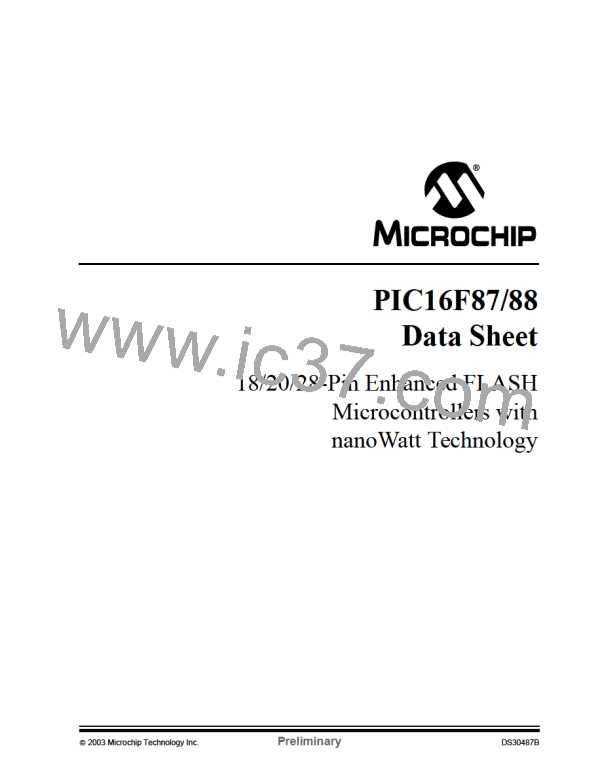PIC16F87/88
receive data. Reading the RCREG register will load bit
RX9D with a new value, therefore, it is essential for the
user to read the RCSTA register before reading RCREG,
in order not to lose the old RX9D information.
11.3.2
USART SYNCHRONOUS MASTER
RECEPTION
Once Synchronous mode is selected, reception is
enabled by setting either enable bit SREN
(RCSTA<5>), or enable bit CREN (RCSTA<4>). Data is
sampled on the RB2/SDO/RX/DT pin on the falling
edge of the clock. If enable bit SREN is set, then only a
single word is received. If enable bit CREN is set, the
reception is continuous until CREN is cleared. If both
bits are set, CREN takes precedence.
When setting up a synchronous master reception:
1. Initialize the SPBRG register for the appropriate
baud rate (Section 11.1 “USART Baud Rate
Generator (BRG)”).
2. Enable the synchronous master serial port by
setting bits SYNC, SPEN and CSRC.
After clocking the last bit, the received data in the
Receive Shift Register (RSR) is transferred to the
RCREG register (if it is empty). When the transfer is
complete, interrupt flag bit, RCIF (PIR1<5>), is set. The
actual interrupt can be enabled/disabled by setting/
clearing enable bit RCIE (PIE1<5>).
3. Ensure bits CREN and SREN are clear.
4. If interrupts are desired, then set enable bit
RCIE.
5. If 9-bit reception is desired, then set bit RX9.
6. If a single reception is required, set bit SREN.
For continuous reception, set bit CREN.
Flag bit RCIF is a read-only bit, which is reset by the
hardware. In this case, it is reset when the RCREG
register has been read and is empty. The RCREG is a
double-buffered register (i.e., it is a two-deep FIFO). It is
possible for two bytes of data to be received and trans-
ferred to the RCREG FIFO and a third byte to begin shift-
ing into the RSR register. On the clocking of the last bit
of the third byte, if the RCREG register is still full, then
Overrun Error bit, OERR (RCSTA<1>), is set. The word
in the RSR will be lost. The RCREG register can be read
twice to retrieve the two bytes in the FIFO. Bit OERR has
to be cleared in software (by clearing bit CREN). If bit
OERR is set, transfers from the RSR to the RCREG are
inhibited, so it is essential to clear bit OERR if it is set.
The ninth receive bit is buffered the same way as the
7. Interrupt flag bit, RCIF, will be set when
reception is complete and an interrupt will be
generated if enable bit, RCIE, was set.
8. Read the RCSTA register to get the ninth bit (if
enabled) and determine if any error occurred
during reception.
9. Read the 8-bit received data by reading the
RCREG register.
10. If any error occurred, clear the error by clearing
bit CREN.
11. If using interrupts, ensure that GIE and PEIE
(bits 7 and 6) of the INTCON register are set.
TABLE 11-11: REGISTERS ASSOCIATED WITH SYNCHRONOUS MASTER RECEPTION
Value on
all other
RESETS
Value on:
POR, BOR
Address
Name
Bit 7
Bit 6
Bit 5
Bit 4
Bit 3
Bit 2
Bit 1
Bit 0
0Bh, 8Bh, INTCON
10Bh,18Bh
GIE
PEIE TMR0IE INTE
RBIE TMR0IF
INTF
R0IF
0000 000x 0000 000u
0Ch
PIR1
—
ADIF
RX9
RCIF
TXIF SSPIF CCP1IF TMR2IF TMR1IF -000 0000 -000 0000
18h
RCSTA
SPEN
SREN CREN
—
FERR
OERR
RX9D
0000 -00x 0000 -00x
0000 0000 0000 0000
1Ah
RCREG USART Receive Register
8Ch
PIE1
—
ADIE
TX9
RCIE
TXIE SSPIE CCP1IE TMR2IE TMR1IE -000 0000 -000 0000
98h
TXSTA
CSRC
TXEN SYNC
—
BRGH
TRMT
TX9D
0000 -010 0000 -010
0000 0000 0000 0000
99h
SPBRG Baud Rate Generator Register
Legend:
x= unknown, - = unimplemented, read as ‘0’. Shaded cells are not used for synchronous master reception.
DS30487B-page 110
Preliminary
2003 Microchip Technology Inc.

 MICROCHIP [ MICROCHIP ]
MICROCHIP [ MICROCHIP ]